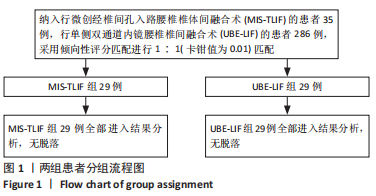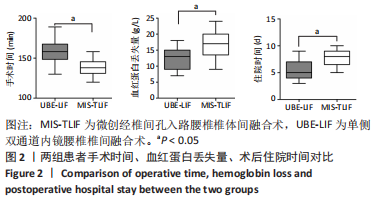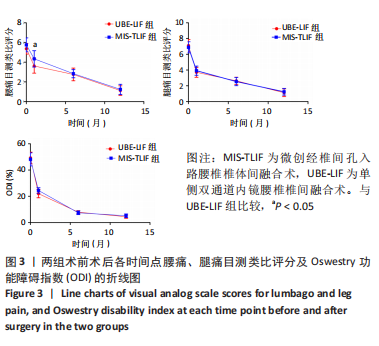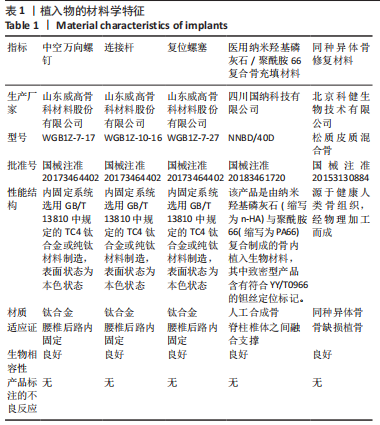中国组织工程研究 ›› 2024, Vol. 28 ›› Issue (12): 1914-1919.doi: 10.12307/2024.061
• 骨科植入物 orthopedic implant • 上一篇 下一篇
倾向性评分匹配两种腰椎融合方案治疗单节段腰椎退行性疾病
万 健1,王 宁1,贝朝涌2,陈远明3,王洪岗1
- 桂林医学院附属医院,1脊柱外科,2创伤外科,广西壮族自治区桂林市 541000;3广西医科大学第二附属医院骨科,广西壮族自治区南宁市 530007
Two lumbar fusion regimens in treatment of single-level lumbar degenerative diseases based on propensity score matching
Wan Jian1, Wang Ning1, Bei Chaoyong2, Chen Yuanming3, Wang Honggang1
- 1Department of Spine Surgery, 2Department of Trauma, Affiliated Hospital of Guilin Medical College, Guilin 541000, Guangxi Zhuang Autonomous Region, China; 3Department of Orthopedics, Second Affiliated Hospital of Guangxi Medical University, Nanning 530007, Guangxi Zhuang Autonomous Region, China
摘要:
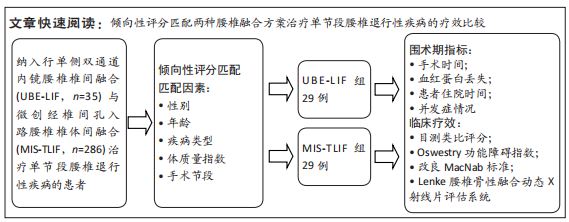
文题释义:
倾向性评分匹配:倾向评分匹配(propensity score matching,PSM)是一种统计学方法,用于处理观察研究的数据。在观察研究中,由于种种原因,数据偏差和混杂变量较多,倾向评分匹配的方法正是为了减少这些偏差和混杂变量的影响,以便对试验组和对照组进行更合理的比较。腰椎融合技术:作为治疗腰椎相关疾病的技术,随着腰椎融合术的日益革新,随之而来也成为被大家热议的话题。在临床中选择何种腰椎融合术式的较量不曾停止,如何选择,各有利弊。
背景:国内外近年来广泛使用单侧双通道内镜技术行椎间融合,但其与微创经椎间孔入路腰椎椎体间融合(minimally invasive transforaminal lumbar interbody fusion,MIS-TLIF)治疗腰椎退行性疾病的临床疗效对比仍较少,单侧双通道内镜技术是否是一种安全、高效的腰椎融合术式有待进一步论证。
目的:对比单侧双通道内镜腰椎椎间融合(unilateral biportal endoscopic lumbar interbody fusion,UBE-LIF)与MIS-TLIF治疗腰椎退行性疾病的临床疗效,探讨更高效的腰椎融合术式。方法:纳入桂林医学院附属医院2020年10月至2022年2月收治的单节段腰椎退行性疾病患者,其中行UBE-LIF的患者35例,行MIS-TLIF的患者286例,采用倾向性评分匹配消除混杂因素,选取性别、年龄、疾病类型、手术节段4个协变量进行1∶1(卡钳值为0.01)匹配,匹配后两组各29例患者纳入研究。比较两组患者围术期中手术时间、血红蛋白丢失量、住院时间;采用目测类比和功能障碍指数对两组患者术前、术后1个月、术后半年、术后1年的功能恢复效果进行评价;末次随访采用改良MacNab标准评定两组疗效的优良率,采用Lenke腰椎骨性融合动态X射线片评估两组的植骨融合情况。
结果与结论:①在手术时间上MIS-TLIF组短于UBE-LIF组(P < 0.05),MIS-TLIF组术中血红蛋白丢失量高于UBE-LIF组、住院时间长于UBE-LIF组,差异有显著性意义(P < 0.05);②两组患者术后1个月、术后半年、术后1年的腰痛目测类比评分、腿痛目测类比评分及Oswestry功能障碍指数相较于术前均有显著降低(P < 0.05);除了术后1个月腰痛目测类比评分,在以上各时间节点随访两组腰痛、腿痛目测类比评分及Oswestry功能障碍指数无明显差异(P > 0.05);③末次随访改良MacNab标准疗效评定结果显示,UBE-LIF组优良率为93%(27/29);MIS-TLIF组优良率为90%(26/29),两组差异无显著性意义(P > 0.05);④Lenke腰椎骨性融合动态X射线片评估系统进行评定后,UBE-LIF组A级21例,B级5例,C级3例,融合率为90%;MIS-TLIF组A级20例,B级5例,C级4例,融合率为86%,两组差异无显著性意义(P > 0.05);⑤提示UBE-LIF与MIS-TLIF两种术式治疗单节段腰椎退行性疾病的临床疗效相近,均具有创伤小、出血少、住院时间短的优点;此外,UBE-LIF术后早期腰痛相对较轻,学习曲线相对平缓,虽然UBE-LIF组的手术时间较MIS-TLIF长,仍不失为一张安全、高效的术式。
https://orcid.org/0009-0007-8857-4146 (万健);https://orcid.org/0000-0003-3826-7213 (王宁)
中国组织工程研究杂志出版内容重点:人工关节;骨植入物;脊柱;骨折;内固定;数字化骨科;组织工程
中图分类号:
